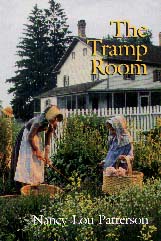|
________________
CM . . . .
Volume V Number 21 . . . . June 18, 1999
When Elizabeth, in her role as junior interpreter for the Joseph Schneider
Haus Museum in Kitchner, Ontario, falls asleep while listening to a
story-teller entertaining the children whose parents have come to the
museum for a lecture given by her mother, she wakes to find herself in the
same house, but transported back to the 1850s. Her presence is accepted
there without question. She seems to fit in somewhere between a daughter
and a hired hand, and she witnesses the arrival of 'the tramp boy,' a
young lad who is painfully underfed, soaking wet, and seeking asylum with
the Mennonite family of Joseph Schneider and his wife Sarah. He never does
get a name, but he is sheltered and hidden as required to keep him from
being recaptured by the man who is falsely claiming to be his apprentice
master. In the meantime, both he and Elizabeth work on the farm, caring
for the animals, and doing all the household chores that must be done each
day. Luckily, Elizabeth has some idea about these from her work at the
museum, and so she is able to contribute to the cleaning, cooking,
spinning and candle-making, as well as joining in the celebrations, while
the tramp boy is a carpenter and cabinet maker who is willing to help with
anything that needs doing. Elizabeth's ability to read and write well make
it possible for her both to teach the young Schneiders and also, on her
own initiative, to write to the tramp boy's mother in Pennsylvania to tell
her where her son has ended up after having been abducted. With the
reunion of mother and son, the reason for Elizabeth's presence out of her
own time has been fulfilled, and she returns to her own time where the
gift that the boy has made for her suddenly turns up as a new acquistion
at the Joseph Schneider Haus.
The Tramp Room begins awkwardly, with stilted conversation between
Elizabeth and her mother attempting to set the scene and explain in
advance why Elizabeth should be so adaptable to conditions of life a
hundred and fifty years ago. As soon as she actually is transported,
however, which happens within the first five pages, things pick up, and
the strengths of the book begin to show. These are mostly the loving
descriptions of life on a Mennonite farm of the period, with its many
chores which are transformed into art because they are done with love to
the glory of God. It is a somewhat idealized existence---the babies don't
cry, the children don't whine when they are tired, everyone stays healthy
and helps cheerfully and willingly with all the work, and meals appear by
magic, with great pots of soup and loaves of bread coming to the table
without anyone's ever seeming to spend any time chopping onions or
kneading dough. The joy is in the details, however, and they are
fascinating, from the preparation of flax for spinning to making candles
and quilting potholders. The strengths and weaknesses of the apprentice
system are the basis for the story line and are also interesting in
themselves.
As an added benefit, the book is paperback, but beautifully bound, with a
picture of the Joseph Schneider Haus on the cover, and a nice supple back
that allows the book to open fully and easily for comfortable reading.
Recommended.
Mary Thomas is taking a busman's holiday, working in the library at
Oxford Brookes University while on leave from elementary school libraries in Winnipeg, MB.
To comment on this title or this review, send mail to cm@umanitoba.ca.
Copyright © the Manitoba Library Association.
Reproduction for personal use is permitted only if this copyright notice
is maintained. Any other reproduction is prohibited without
permission.
Published by
TABLE OF CONTENTS FOR THIS ISSUE - JUNE 18,
1999.
AUTHORS |
TITLES |
MEDIA REVIEWS |
PROFILES |
BACK ISSUES |
SEARCH |
CMARCHIVE |
HOME
|

